-
A 2-DAY ONLINE COURSE to learn how to:
CALCULATE CALIBRATION UNCERTAINTY
Sick of WASTING TIME trying to figure it out? Learn to calculate and report calibration uncertainty in accordance with ISO/IEC 17025:2017 and ILAC P14:01/2013.
Register Now For $1199
-
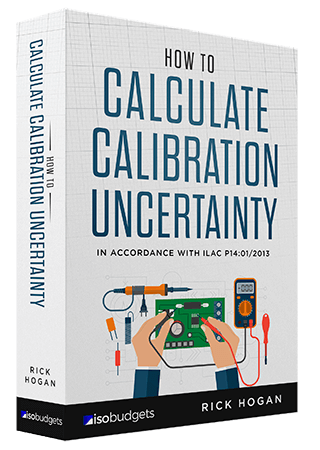
LEARN HOW TO CALCULATE CALIBRATION UNCERTAINTY
WITH RICK HOGAN
Do you want to calculate measurement uncertainty for your calibration reports?
If you answered YES to the question above, then you’ve come to the right place.
Estimating and reporting calibration uncertainty is a difficult task for many laboratory personnel. So, you are not alone.
People tell me that they struggle with:
- Calculating measurement uncertainty
- Using the equations in their scope of accreditation
- Finding UUT resolution
- Calculating UUT repeatability
- Reporting uncertainty to two significant figures
I constantly get questions about:
- How do I calculate uncertainty using the equations in my scope?
- Do I need to include UUT resolution? It makes my uncertainty too large!
- How many samples should I collect for UUT repeatability?
- What are significant figures?
- How do I include this in my calibration reports?
Well today, I am here to answer all of your questions!
In this course, I’ll walk you step-by-step through the entire process of calculating calibration uncertainty and reporting it in your certificates. The course is designed to teach you all of the information and processes in a way that is simple and easy to learn.
With high-quality videos and examples along the way, you will be able to calculate and report calibration uncertainty in no time. You are going to learn EVERYTHING that you need to know for ISO/IEC 17025:2017 accreditation and I am going to hold your hand and guide you through the entire process. Plus, you get access to all of the tools (including calculators), tips, and resources that you need to get started.
⚠ IMPORTANT
This Course is for Estimating Uncertainty for Your Calibration Reports, NOT Your Scope of Accreditation.
This Course is for You, if…
✔ You work in a calibration laboratory
✔ Your laboratory is ISO/IEC 17025 accredited, or wants to be
✔ You want to learn the easy way to calculate and report measurement uncertainty
In this Course, you’ll learn:
1 ISO/IEC 17025:2017 and ILAC P14 Requirements
Learn the ISO/IEC 17025:2017 and ILAC P14 Requirements for Calculating and Reporting Calibration Uncertainty.
2 How to Calculate Calibration Uncertainty
Learn how to calculate and combine CMC Uncertainty, UUT Resolution, and UUT Repeatability.
3 Estimating Measurement Uncertainty with the GUM Method
Learn how to characterize, convert, and combine uncertainty components and expand uncertainty to a 95% confidence interval (where k=2) using the GUM method.
4 How to Report Measurement Uncertainty
Learn how to report measurement uncertainty in your calibration certificates. Plus, learn how to write and an uncertainty statement.
5 How to Integrate it into Your Calibration Process
Learn how to add an uncertainty calculator to your calibration checklist & templates in Excel.
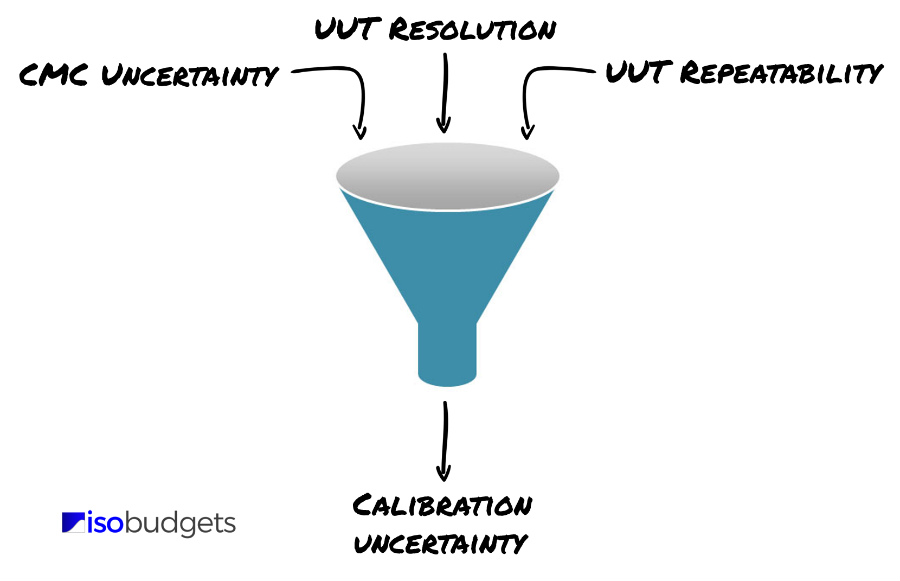
MEET YOUR INSTRUCTOR

HI, I’M RICK HOGAN
I’m a pro at estimating uncertainty. Here’s how I can help you.
I’ve been estimating uncertainty in measurement since 2008. Over the years, I have developed simple and clever ways to calculate measurement uncertainty.
In 2010, ILAC released the first version of the P14 policy which changed how calibration laboratories calculate and report measurement uncertainty.
To prevent ruining laboratory production, I developed a process to estimate calibration uncertainty quickly. Using Microsoft Excel, I created an uncertainty calculator that could be added into calibration checklists and templates that would automatically calculate calibration uncertainty in accordance with ILAC P14.
Nearly 10 years later, I am still using the same process because it works!
Most commercial calibration software has not yet integrated this capability (even though I have submitted more than 100 complaints).
Over the years, I have taught clients how to calculate uncertainty and report it in their calibration certificates.
Now, you can learn the same process that I use to calculate calibration uncertainty and increase your laboratory production.
However, it does not stop there! You can use this process to quickly QA calibration reports before submitting them to a customer. Plus, you can use it to calculate uncertainty for your proficiency tests and interlaboratory comparisons.
Learning this process can really help you and your laboratory. That’s why I created How to Calculate Calibration Uncertainty to help calibration laboratories learn from my successes and failures so they can meet ISO/IEC 17025:2017 requirements.
COURSE CURRICULUM
This is a 2 day course designed to teach you how to estimate calibration uncertainty in 4 fundamental steps. Each step gives you access to new lectures and demonstrations designed to teach you a new set of skills.
Take a look below at the course curriculum and summary:
STEP 1 – The Requirements
Lesson 01: ISO/IEC 17025:2017 Requirements
Learn all of the requirements for estimating and reporting measurement uncertainty.
Lesson 02: ILAC P14:01/2013 Requirements
Learn the international policy and guidelines for reporting uncertainty in calibration certificates.
STEP 2 – The Uncertainty Components
Lesson 03: How to Calculate CMC Uncertainty
Learn how to calculate CMC Uncertainty using the information in your scope of accreditation and my exclusive calibration uncertainty calculator.
Lesson 04: How to Find UUT Resolution
Learn how find the UUT resolution of digital devices, analog devices, and artifacts. This lesson is packed with tons of examples.
Lesson 05: How to Calculate UUT Repeatability
Learn how calculate UUT Repeatability without collecting a million samples and hurting your laboratory’s productivity.
STEP 3 – Estimating Uncertainty
Lesson 06: How to Characterize and Convert Uncertainty
Learn how to characterize and convert uncertainty to standard deviations. Plus, learn how to automate the entire the process.
Lesson 07: How to Calculate Combined Uncertainty
Learn how to automatically combine uncertainty sources using the root sum of squares method recommended by the GUM. Plus, learn my 2-step function that combines uncertainty without typing long equations.
Lesson 08: How to Calculate Expanded Uncertainty
Learn how to automatically calculate the expanded uncertainty that guarantees a 95% confidence interval with a coverage factor where k=2.
STEP 4 – Reporting Uncertainty
Lesson 09: How to Evaluate Calibration Uncertainty
Learn to verify and validate your calculated calibration uncertainty using 4 exclusive evaluation techniques.
Lesson 10: How to Report Uncertainty
Learn how to report uncertainty in your calibration reports. Plus, learn how to draft an uncertainty statement for your certificates.
Lesson 11: How to Add An Uncertainty Calculator to Calibration Templates in Excel
Learn how to add an uncertainty calculator to your calibration templates and quickly estimate uncertainty for your measurement results.
YOU GET ACCESS TO THE FOLLOWING
When you enroll, you will get access to the following:
11 Course Videos
Learn how to calculate calibration uncertainty watching high quality video lectures. I will teach you everything you need to know step-by-step with simple and easy to follow instructions.

5 Demonstration Videos
Watch me estimate calibration uncertainty step-by-step so you can see exactly how to do it yourself. These demonstrations take each lecture to next level by showing you how to calculate measurement uncertainty.
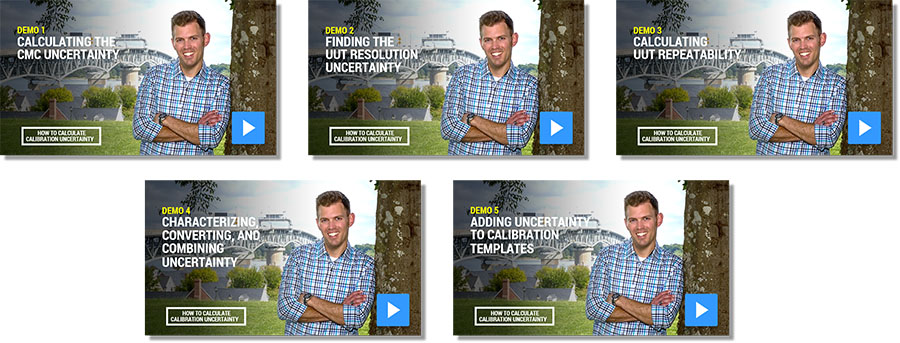
11 PowerPoint Lectures
Get access to the PowerPoint slides used in each lecture. Use them to follow along, take notes, or just refresh your memory.
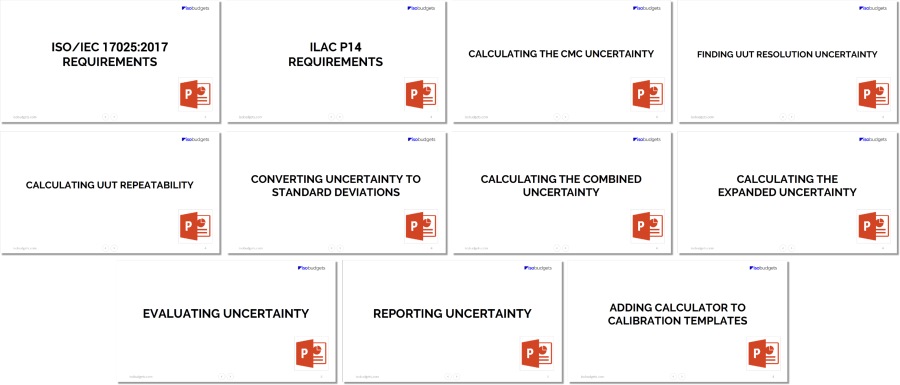
1 Uncertainty Calculator
Get my popular Calibration Uncertainty Calculator for Microsoft Excel, so you estimate calibration uncertainty during and after the course.
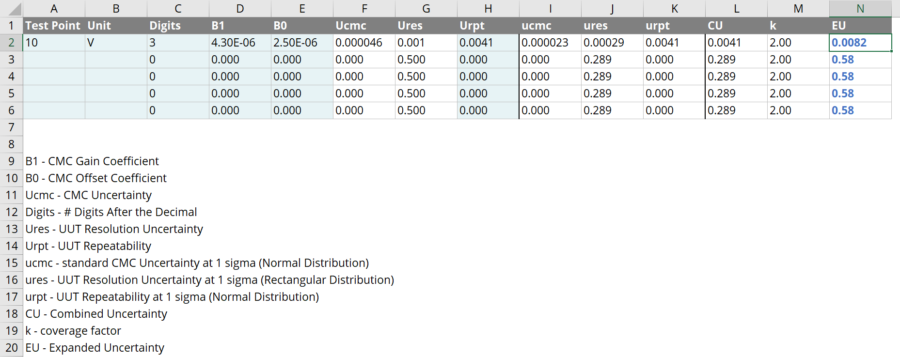
CERTIFICATE OF COMPLETION
You will receive a training certificate when you complete this course. Upon completion, it will be available for you to download and print.
It is recommended to add this certificate to your training record and update your list of qualifications.
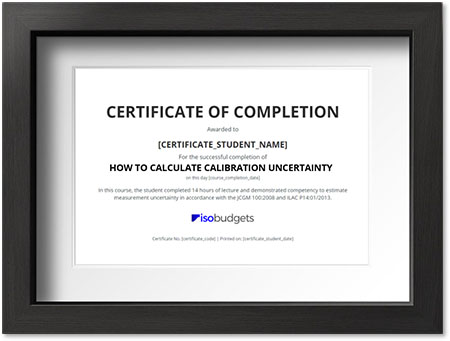
AFTER COMPLETING THE COURSE
After you complete the course and earn your training certificate, you should expect to continue applying what you have learned.
I encourage you to keep estimating uncertainty for the calibrations performed in your laboratory and reporting the results in your calibration certificates.
You should immediately implement what you have learned into your laboratory process. The more you calculate calibration uncertainty;
- you will get better at estimating uncertainty,
- it will become much easier,
- you will get significantly faster, and
- you will find new ways to imolement it into your processes.
Before you know it, you will become an expert and the go-to guy/gal at your organization.
I recommend implementing what you learned into these three processes:
- reporting calibration results,
- reviewing and approving your calibration reports (before sending them to your customer), and
- reporting proficiency testing results,
YOUR EXPECTED RESULTS
When you complete this course, you should expect the following results:
✔ Confidently estimate uncertainty for your calibrations.
✔ Professionally report uncertainty in your calibration certificates.
✔ Easily meet ISO/IEC 17025:2017 and ILAC P14:01/2013 requirements.
HOW IT WORKS
Completing this course and learning how to estimate uncertainty is a pretty simple process. Just follow these 5 steps:
- Login
- Watch the videos
- Follow the demonstrations
- Complete the course
- Earn your certificate
IS THIS COURSE FOR YOU?
This course is recommended for people who routinely estimate calibration uncertainty for their laboratory, including:
- Quality Managers,
- Technical Managers,
- Technicians,
- Engineers,
- Quality Control personnel, and/or
- Data Entry Personnel.
If you are the person who estimates and reports measurement uncertainty for your laboratory, this course is recommended for you.
Plus, this process works for all types of calibration laboratories, including:
- Electrical – DC/LF,
- Electronic – RF/Microwave,
- Dimensional,
- Mechanical,
- Thermodynamic,
- Acoustic & Vibration,
- Photometry,
- Chemical,
- and many more.
COURSE LENGTH
This is a 2-day course that is 100% online.
You have up to 30 days to complete the course. Plus, you get access to the course and all of its material for 365 days so you can go back, watch the videos, and review the information any time you like.
That’s 1 year of unlimited access included! If you need more time, notify the instructor to request a free extension.
COURSE REQUIREMENTS
To participate and complete this course, you will need the following;
- A computer,
- An internet connection,
- An email account,
- Microsoft Excel, Google Sheets, or Apple Numbers, and
- Adobe PDF Reader
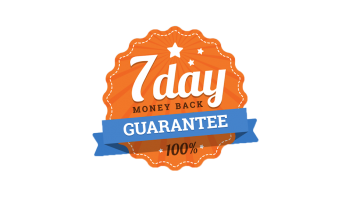
7 DAY, RISK FREE, MONEY BACK GUARANTEE
I guarantee that this course will teach you how to estimate and report calibration uncertainty for ISO/IEC 17025. If you are not satisfied, I will refund 100% of your money within the first 7 days of starting the course. After 7 days, I will offer you a free extension to repeat the course and/or provide you with a 1-on-1 coaching call.
CANCELLATION & REFUND POLICY
You may cancel your enrollment at any time. To receive a refund, you must notify the instructor and cancel your enrollment within the first 7 days. After 7 days, you may cancel your enrollment but will not receive a refund. To notify the instructor, send an email to [email protected].
WANT TO LEARN HOW TO CALCULATE CALIBRATION UNCERTAINTY? ENROLL TODAY.
Join this course because you work for a calibration laboratory that needs to meet ISO/IEC 17025:2017 requirements and you need help with estimating measurement uncertainty.
But you are free to choose any measurement uncertainty training you like. Whether you want to teach yourself or take another training course, please pick the method that works best for you.
However, you should join this course. You will learn 10X more in less time!
The choice is yours.
PRICING
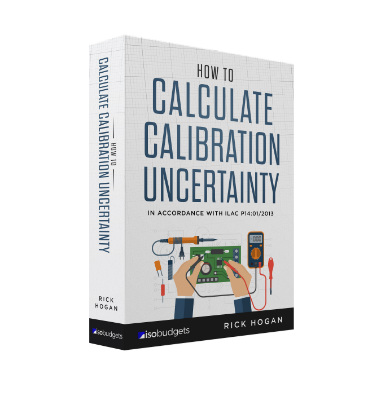
How to Calculate Calibration Uncertainty
Online Training Course
$1199
ENROLL NOW FOR $1199LIMITED SEATS AVAILABLE!
Frequently Asked Questions
How long do I have access to the course?
You will have one year (365 days) access to the course.
What equipment/software will I need to complete the course?
To complete this course, you will only need a computer, an email account, an internet connection, and Microsoft Excel, Google Sheets, or Apple Numbers. We will provide with uncertainty calculator that you will use for the course.
It is recommended to have access to test equipment and calibration reports in order to perform an uncertainty analysis during the course.
What do I do if I need help?
If you have a question related to this course, email [email protected]. Thanks!
How long is the course?
Plan to take about 2 days to 1 week to complete the course. Some people complete the course in 1 day.
There are 16 videos totaling over 6 hours of content. Most videos are 15–30 minutes long, with the shortest video around 9 minutes and the longest about 35 minutes.
Can I pay with PayPal?
Yes. On the checkout page under the “Billing Information” section, select the “Pay with PayPal” button. This will allow you to pay with PayPal.
What if I am unhappy with the course?
Oh no! We don’t want that! We offer a 7-day money back guarantee. If you are unhappy with the course for any reason, let us know and we will refund your payment within 30 days. We would appreciate notification within the first 7 days of the course.
When does the course start and finish?
The course will be offered periodically; make sure to join our mailing list to receive notifications when the course reopens. Once you have enrolled, you have ongoing access and assistance from me. The course is self-paced and you may take as long as you need to complete it.
WHAT STUDENTS ARE SAYING
This was a great courseIt’s full of good examples and tips to find information.
Secrets to evaluate and reduce your uncertainties.
And the way that Richard coaches you makes this course an excellent invest.Congratulations Richard.
DIEGO GONZALEZStudent
The course was well taught by Richard, he did a great job of watering down the confusing points to point out what they really are looking for in those sections. The course helped clear up a lot of things for me and I will be strongly recommending to others who are interested. I really enjoyed how this course was taught and how the schedule went. Richard is also very easy to get in touch with to ask any questions. AUSTIN BROWNELLStudent
AUSTIN BROWNELLStudent
Great course with a lot of information given, very easy to follow along with and went at a good pace with lessons and projects. JAMES MAYStudent
JAMES MAYStudent
A FINAL NOTE
Stop wasting time trying to figure it out on your own. Let me show you how to calculate and report calibration uncertainty. It is much easier than you think. Don’t risk getting a deficiency. It will cost you more time and money than this course to fix it. Plus, you will regret it.
Have you ever got a deficiency?
Then, you should know everything that is involved in correcting it. You have to:
- Write up a nonconformance,
- Conduct an investigation to:
- Find the cause,
- Find other affected work/results
- Take corrective action to:
- Fix the problem,
- Draft/update policies and procedures,
- Provide training to personnel,
- Notify affected customers,
- Recall affected work
- Submit objective evidence to your accreditation body,
- Wait for them to:
- Approve your corrective actions, or
- Ask you to do more
Deficiencies take a long time to resolve! You could be stuck spending months trying to fix them while your accreditation body tells you that it isn’t good enough.
Worse yet! Your lab could get stuck living on extensions for months and your customers calling you each month questioning whether or not you are accredited.
Don’t let this happen to you. Just let me help you.